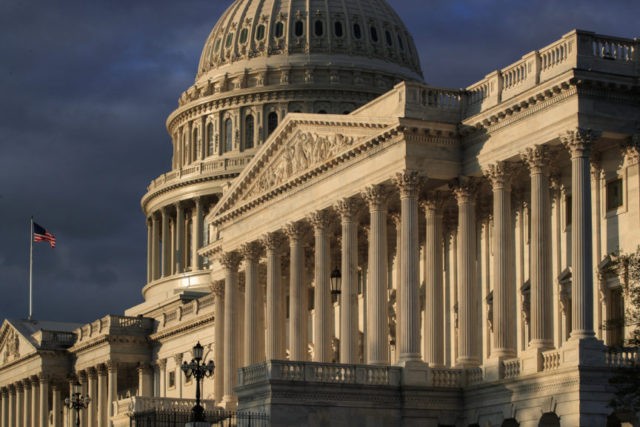Republicans are under fire after proposing to slap the label “temporary” on many of the signature tax cuts in their tax overhaul. The history of tax cuts suggests that much of this criticism is overblown and more about partisan politics than economic reality.
Very recent history makes it clear that temporary tax cuts are not always temporary–and permanent tax cuts are not usually permanent.
The revised Senate tax bill labels the cut to the corporate tax rate permanent while setting a 2025 expiration date on cuts to individual rates, the expansion of the child tax credit, and the doubling of the standard deduction. The cuts to pass-through businesses also get tagged as temporary.
This has invited scathing criticism from Democrats that is as misplaced as it is cynical.
“This is the bill you write if you want to build a tax code around a double standard,” Senator Ron Wyden, the top Democrat on the tax-writing Senate Finance Committee, said. “The corporate tax breaks are permanent — written in ink, set in stone, locked in place with the key thrown away. But families have to settle for temporary tax cuts.”
But Wyden knows this is nonsese. Republicans do not actually want to see the tax cut expire. Some have said they have no intention of actually allowing the tax cuts to expire. So why write a law that sets an expiration date?
The expiration date is a reflection of the fact that Democrats have made clear that they will not support the Republican bill under any conceivable circumstances. As a consequence of this partisan resistance, Republicans will need to pass the bill in the Senate with only Republican votes–and they aren’t enough of those to pass the bill if Democrats attempt to filibuster it.
To pass the bill with the slim Republican majority, Republicans have to make it comply with byzantine budget rules that forbid legislation from adding to the debt beyond a ten-year threshold. So by scheduling some tax cuts to expire before that, they make passing the bill a possibility.
As a practical matter, this makes little difference. If Congress is in a tax raising mood in 2025, taxes will be likely to increase. If not, the tax cuts will likely be extended. But nothing in whether a particular tax cut was labeled permanent or temporary in 2017 will make any difference whatsoever. The truth is that today’s Congress cannot lock a future Congress into a particular tax policy. Contrary to Senator Wyden, tax cuts may be written in ink but nothing is set in stone. Everything about taxes is written in sand.
This is evident in the recent history of tax cuts. A number of tax cuts passed between 2001 and 2004 during the Bush administration were supposed to sunset. Few of the provisions expired on schedule. Instead, they were extended time and again–as Republicans had planned from the start. Indeed, many of the Bush era tax cuts were extended in 2010 under the Obama presidency as part of a budget deal with Congressional Republicans. So not even a change of administration and the passage of nearly a decade dooms a so-called temporary tax cut.
On the flip side of the coin, so-called permanent tax cuts often have limited lifetimes. The Reagan administration cut the top marginal tax rate all the way down to 28 percent in 1988–supposedly on a permanent basis. But that rate lasted only until 1991, when George H.W. Bush famously broke his “read my lips” promise and agreed to a tax hike.
The reason why so many temporary tax cuts tend to become permanent are crystal clear. Politicians in both parties are loath to raise taxes on working Americans. They understand there is a political cost to killing popular tax breaks or raising rates on middle income voters. So tax cuts that extend to these groups tend to get extended.
That political reality also explains why Republicans chose to put a sunset date on the individual tax cuts rather than the corporate tax rate. Democrats may be willing to allow the corporate tax cut to actually expire but are viewed as less likely to hike the individual income tax cuts, since that would mean hurting most working Americans.
While critics of the Senate Republicans may see this as politically cynical, it is also profoundly small-d democratic and fiscally responsible. Sunsetting popular tax cuts that may contribute to a larger budget deficits allows Americans to revisit the choice between debt and taxes in a few years. At that point, the fiscal costs of the tax cuts and the economic benefits will be clearer–not based on budget projections of government bureaucrats. If Americans still prefer cuts, they will likely remain in place. If they don’t, politicans will allow them to sunset.
Because there’s nothing necessarily temporary about temporary tax cuts or permanent about permanent tax cuts, there’s no economic cost to scheduling some tax cuts to expire. Households and businesses will plan their spending, saving, and investment based on their expectations of what will really happen rather than what the letter of the law says. Under standard economic theory, in fact, households and business see through tax cuts and deficits to anticipate whatever they expect economic reality to be.
So why the budgetary shenanigans? Because under law, the official scorers of tax bills are not allowed to employ “rational expectations” when projecting government revenue and deficit spending. They must pretend as if they believe expiring tax cuts will expire on schedule and permanent tax cuts will last forever. In this make-believe world of government budgets, enacting make-believe sunsets for tax cuts makes sense.

COMMENTS
Please let us know if you're having issues with commenting.